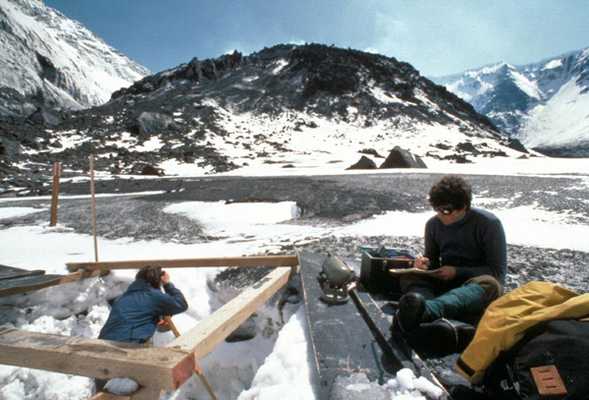
by Christopher Keane Thursday, January 5, 2012

Geologists working on Mount St. Helens in Washington. Courtesy USGS Cascade Volcano Observatory, ESW Image Bank
This has been a vintage year for the health of the geoscience workforce in the United States. Overall enrollments and degrees in geoscience programs increased 5 to 10 percent — as they’ve been doing for the past four years — this year reaching nearly 25,000 undergraduate majors and 10,000 graduate students across the country. Employment opportunities for geoscientists continue to be widespread, with more jobs available than people to fill them.
Despite these sunny prospects, there are clouds gathering on the horizon: After years of talking about it, what has been termed the “Great Crew Change” — when a large cohort of retiring geoscientists will vacate positions that will need to be filled by younger colleagues — is now upon us. This year marks the first time that the crew change is no longer an event on the horizon, but an immediate situation we must recognize and deal with. And that is both good and bad.
The challenge upon is us is that the baby boomers are retiring at a rate faster than they can be replaced. In almost all technical fields, especially in the geosciences (pdf), the remaining (and incoming) workforce is not nearly large enough to fill the void.
In 2011, the American Geosciences Institute (AGI) Geoscience Workforce program measured the first wholesale attrition of geoscience professionals, due to retirements. It has started in the federal geoscience workforce, especially in the nonregulatory agencies like the U.S. Geological Survey and NOAA. However, the demographics of the oil and gas industry, as well as the mining industry, indicate that this same phenomenon will start affecting these industries within the next two years. It will also soon start affecting academia, where it would have already taken effect were it not for the tendency of faculty to work beyond the normal retirement age.
Of course, in this time of a troubled economy, the prospect and current reality of a strong geoscience job market (pdf) is welcome news. It becomes a problem, though, when the number retiring is so much larger than the number of remaining and incoming workers. By 2021, we expect to have seen 125,000 U.S. geoscientists retire. The next-generation workforce is only about one-third the size (pdf) of the retiring population. Add the fact that forecasts by the U.S. Department of Labor suggest that by 2021 we could add 72,000 new geoscience jobs to the current 250,000 geoscience positions, and you can see the magnitude of the problem: We’re facing a deficit of 150,000 geoscientists by 2021!
The reality is that we won’t have enough educated geoscientists to fill these positions. But those 150,000 jobs will not be left unfilled. Free markets excel at solving problems like this. The most likely solutions will be substitution: Individuals with nongeoscience backgrounds take on the necessary work. That opens up a whole other can of worms. There are other solutions to the gap, and one that poses great opportunities is innovation making the geosciences substantially more efficient.
It’s one thing to fill a position in a consulting firm or oil company where teams with diverse expertise are harnessed to solve problems, but hiring in narrowly specialized areas such as academia is challenging. Faculty embody a great specialized pool of expertise and replacing those individuals is not a simple task, but it is critical to make the future development of the workforce sustainable.
This is particularly challenging in specific disciplines such as mining. Oft-derided as a dead area, mining-related geoscience graduates are in high demand, in both industry and academia. However, the number of programs and faculty to teach the next generation of mining-related geoscience graduates are dwindling, as are specific specialties such as underground ventilation. If the appropriate faculty are not available to educate students, then not only will it be difficult to produce the graduates needed, but also our society risks losing entire swaths of pertinent knowledge — knowledge that will only be available in the archives of journals or a few books, or lost forever as professionals retire and pass on without disseminating their knowledge. Most of our institutions lack robust inter-generational knowledge transfer. With these changing demographics, will some geoscience skills and knowledge need to be rediscovered?
This was a good year overall for geoscientists, but it also marks the start of a decade of great change. In that change will come great opportunities for those workers who are nimble, innovative and focused, but we will also see the geosciences needing to embrace new sources of human capital: Evolution is not only necessary, but inevitable.
© 2008-2021. All rights reserved. Any copying, redistribution or retransmission of any of the contents of this service without the expressed written permission of the American Geosciences Institute is expressly prohibited. Click here for all copyright requests.